Thursday, June 13, 2013
It is June, it is June,
the pomegranates are in flower,
the peasants are bending cutting the bearded wheat.
The pomegranates are in flower
beside the high road, past the deathly dust,
and even the sea is silent in the sun.
Short gasps of flame in the green of night, way off
the pomegranates are in flower,
small red flowers in the night of leaves.
And noon is suddenly dark, is lustrous, is silent and dark
men are unseen, beneath the shading hats;
only, from out the foliage of the secret loins
red flamelets here and there reveal
a man, a woman there.
???Andraitx???Pomegranate Flowers, by D.H. Lawrence
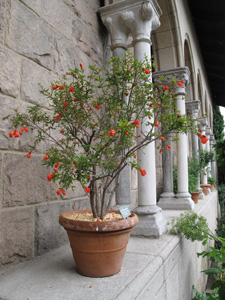
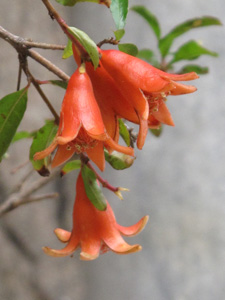
From left to right: The vivid scarlet blossoms of a potted dwarf pomegranate tree in full flower glow against the gray stone of the blind arcade in Bonnefont garden; detail of pomegranate flowers. Both dwarf and standard forms of pomegranate are grown here. Although cultivated for hundreds of years, the dwarf form is not medieval, but it lends itself to pot culture, and can be more easily managed than the full-sized tree. Photographs by Carly Still
Although these photographs were taken just a few days ago on a gray day in Bonnefont garden, this post is coming from sunny California, where I am participating in a panel discussion on museums and gardens at the Getty Center in conjunction with an exhibition curated by Bryan Keene. Read more »
Tags: bay, fig, laurel, olive, pomegranate
Posted in Food and Beverage Plants, Gardening at The Cloisters | Comments (6)
Friday, October 28, 2011
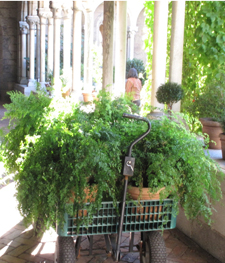
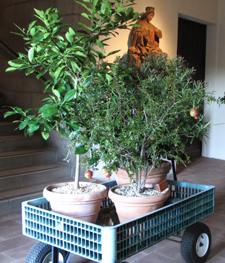
Potted plants too tender to spend the winter in Bonnefont garden are trucked inside and brought up to Cuxa cloister, which is??glazed in mid-October. Mediterranean plants such as bitter orange, myrtle, and bay laurel spend the cold season in the sunny arcades and??are brought back out to the herb garden when the glass comes down in mid-April. Left:??A wagonload of maidenhair fern in the arcade of Bonnefont garden. Right:??oranges and pomegranates en route to Cuxa cloister.?? Photographs by Carly Still
While the medieval plant collection at The Cloisters includes a good number of northern European species, a great many of the plants grown in the Bonnefont Cloister herb garden are Mediterranean in origin. Not all of these southern European plants are hardy for us here in New York City. The garden is a sheltered U.S.D.A. Hardiness Zone 7, and the fig tree (Ficus carica), poet’s jasmine (Jasminum officinale), and lavender (Lavandula angustifolia) do just fine outdoors, but more tender species like bitter orange (Citrus aurantium), rosemary (Rosmarinus officinalis), bay laurel (Laurus nobilis), and dittany of Crete (Origanum dictamnus) must be brought inside and protected from the cold. Read more »
Tags: Albertus Magnus, bay, Citrus aurantium, cucumber, cucurbit, dittany, fern, ficus carica, fig, jasmine, Jasminum officinale, laurel, Laurus nobilis, Lavandula angustifolia, Lavender, maidenhair, myrtle, orange, Origanum dictamnus, rosemary, Rosmarinus officinalis, santolina, winter
Posted in Food and Beverage Plants, Fragrant Plants, Gardening at The Cloisters, Introduction, Magical Plants, Medicinal Plants, Medieval Agriculture, Plants in Medieval Art | Comments (2)
Friday, September 23, 2011
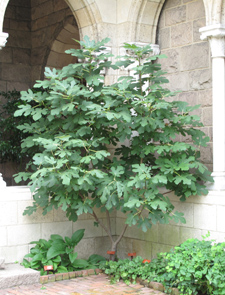

A young fig tree flourishing in a sheltered corner of Bonnefont garden; detail of the ripe fruit (click to see full image)???note the tiny hole in the base of the fig at the lower right, and the milky sap that exudes from the stems when the figs are picked.??This latex was a medicament and a rennet; it was also used as a mordant in medieval gilding and as a binder in the preparation of egg tempera.?? Photographs by Deirdre Larkin
So when the woman saw that the tree was good for food, and that it was a delight to the eyes, and that the tree was to be desired to make one wise, she took of its fruit and ate; and she also gave some to her husband, and he ate.
Then the eyes of both were opened, and they knew that they were naked; and they sewed fig leaves together and made themselves aprons.
???Genesis 3:6, 7
Much of the plant lore of the Middle Ages, like many other aspects of medieval culture, was a synthesis of classical and biblical tradition. The Tree of Knowledge is not named in the biblical account of the Fall; more than one species has been identified with the forbidden fruit, and the fig is among them. In Greco-Roman culture, the fig was associated with fertility and with the female genitalia. D. H. Lawrence??explores??this complex of cultural associations in his remarkable poem “Figs” (listen to a reading of this poem on YouTube).
Read more »
Tags: Adam, Alcinous, Athenaeus, Bugiardini, De Materia Medica, Deipnosophists, Dioscorides, Eisen, Eve, ficus carica, fig, forbidden, Genesis, Hildegard of Bingen, Pliny, Rumina
Posted in Food and Beverage Plants, Medicinal Plants | Comments (1)






